![]()
![]()
![]()
Use LEFT and RIGHT arrow keys to navigate between flashcards;
Use UP and DOWN arrow keys to flip the card;
H to show hint;
A reads text to speech;
82 Cards in this Set
- Front
- Back
|
What does "Codominance" mean? Example?
|
- Both alleles contribute to the phenotype of the heterozygote
- Eg, blood groups: A, B, AB |
|
|
What does "Variable Expressivity" mean? Example?
|
- Phenotype varies among individuals with the same genotype
- Eg, 2 patients with neurofibromatosis type 1 (NF1) may have varying disease severity |
|
|
What does "Incomplete Penetrance" mean? Example?
|
- Not all individuals with a mutant genotype show the mutant phenotype
- Eg, BRCA1 gene mutations do not always result in breast or ovarian cancer |
|
|
What does "Pleiotropy" mean? Example?
|
- One gene contributes to multiple phenotypic effects
- Eg, PKU causes many seemingly unrelated symptoms, ranging from mental retardedness to hair/skin changes |
|
|
What does "Imprinting" mean? Example?
|
- Differences in gene expression depends on whether the mutation is of maternal or paternal origin
- Eg, Prader-Willi and Angelman's syndromes |
|
|
What does "Anticipation" mean? Example?
|
- Increased severity or earlier onset of disease in succeeding generations
- Eg, Huntington's Disease |
|
|
What does "Loss of Heterozygosity" mean? Example?
|
- If a patient inherits or develops a mutation in a tumor suppressor gene, the complementary allele must be detected / mutated before cancer develops; this is not true of oncogenes
- Eg, Retinoblastoma and the two-hit hypothesis |
|
|
What does "Dominant Negative Mutation" mean? Example?
|
- Exerts a dominant effect, a heterozygote produces a non-functional altered protein that also prevents the normal gene product from functioning
- Eg, Mutation of a transcription factor in its allosteric site; non-functioning mutant can still bind DNA, preventing wild-type transcription factor from binding |
|
|
What does "Linkage Disequilibrium" mean?
|
- Tendency for certain alleles at 2 linked loci to occur together more often than expected by chance
- Measured in a population, not in a family, and often varies in different populations |
|
|
What does "Mosaicism" mean? Example?
|
- Occurs when cells in the body differ in genetic makeup d/t post-fertilization loss or change of genetic information during mitosis
- Can be a germ-line mosaic (gonadal mosaicism), which may produce disease that is not carried by parent's somatic cells - Eg, mutation in the embryonic precursor of the bone marrow stem cell → a hematologic mosaic individual - Eg, a chimeric individual is derived from 2 zygotes that subsequently fuse |
|
|
What does "Locus Heterogeneity" mean? Example?
|
- Mutations at different loci can produce the same phenotype
- Eg, Marfan's Syndrome, MEN2B, and homocystinuria all cause marfanoid habitus - Eg, Albinism |
|
|
What does "Heteroplasmy" mean?
|
- Presence of both normal and mutated mtDNA
- Results in variable expression in mitochondrial inherited disease |
|
|
What does "Uniparental Disomy" mean?
|
- Offspring receives 2 copies of a chromosome from 1 parent and no copies from the other parent
- Heterodismy (heterozygous) indicates a meiosis I error - Isodismy (homozygous) indicates a meiosis II error or post-zygotic chromosomal duplication of one of a pair of chromosomes, and loss of the other of the original pair |
|
|
What are the two forms of Uniparental Disomy? What causes each form?
|
- Heterodismy (heterozygous) indicates a meiosis I error
- Isodismy (homozygous) indicates a meiosis II error or post-zygotic chromosomal duplication of one of a pair of chromosomes, and loss of the other of the original pair |
|
|
What is an example of Uniparental Disomy?
|
- Uniparental is eUploid (correct number of chromosomes), not aneuploid
- Most occurrences of UPD → normal phenotype - Consider UPD in an individual manifesting a recessive disorder when only one parent is a carrier |
|
|
What does it mean if a population is in Hardy-Weinberg equilibrium?
|
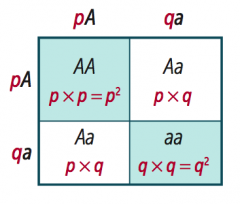
- If "p" and "q" are the frequencies of separate alleles, then
- p^2 + 2pq + q^2 and p + q = 1 - p^2 = frequency of homozygosity for allele p - q^2 = frequency of homozygosity for allele q - 2pq = frequency of heterozygosity (carrier frequency, if an autosomal recessive disease) - Frequency of an X-linked recessive disease in males = q, and in females = q^2 |
|
|
What does the Hardy-Weinberg Law assume?
|
- No mutation occurs at the locus
- No selection for any of the genotypes at the locus - Completely random mating - No net migration |
|
|
What causes imprinting?
|
- At some loci, only 1 allele is active
- The other is inactive (imprinted / inactivated by methylation) - With 1 allele inactivated, deletions of the active allele → disease |
|
|
What are some examples of diseases caused by imprinting? Cause?
|
Inactivation or deletion of genes on chromosome 15 (can also occur as a result of uniparental disomy):
- Prader-Willi Syndrome: Paternal allele is NOT expressed - AngelMan's Syndrome: Maternal allele is NOT expressed |
|
|
What is the cause of Prader-Willi Syndrome? Symptoms?
|
- Paternal allele on chromosome 15 is not expressed (d/t inactivation or deletion), can also be caused by uniparental disomy
- Symptoms: mental retardation, hyperphagia, obesity, hypogonadism, hypotonia |
|
|
What is the cause of Angelman's Syndrome? Symptoms?
|
- Maternal allele on chromosome 15 is not expressed (d/t inactivation or deletion), can also be caused by uniparental disomy
- Symptoms: mental retardation, seizures, ataxia, inappropriate laughter |
|
|
What genes are often affected by autosomal dominant modes of inheritance? Who is affected? Effects? Diagnosis?
|

- Defects in structural genes
- Many generations, both male and female, are affected - One gene contributes to multiple phenotypic effects - Family history is crucial to diagnosis |
|
|
What genes are often affected by autosomal recessive modes of inheritance? Who is affected? Effects?
|
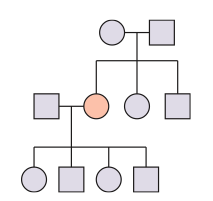
- Often defects in enzymes, causing a deficiency
- 25% of offspring from 2 carrier parents are affected - Usually seen in only 1 generation - Commonly more severe than dominant disorders, patients often present in childhood |
|
|
Who is affected by X-linked recessive modes of inheritance? Characteristics?
|
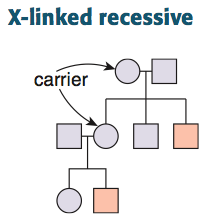
- Sons of heterozygous mothers have a 50% chance of being affected
- No male-to-male transmission - Commonly more severe in males - Females usually must be homozygous to be affected (meaning father is affected by illness too) |
|
|
Who is affected by X-linked dominant modes of inheritance? Characteristics?
|
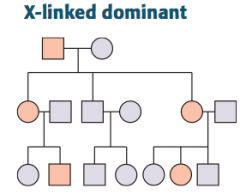
- Transmitted through both parents
- Either male or female offspring of the affected mother may be affected - All female offspring of the affected father are affected |
|
|
What is an example of an X-linked dominant disease? Implications?
|
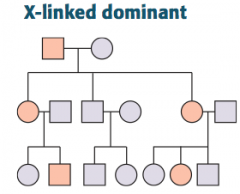
Hypophosphatemic Rickets
- AKA Vitamin D-resistant rickets - Results in increased phosphate wasting at proximal tubule - Results in rickets-like presentation |
|
|
Who is affected by mitochondrial modes of inheritance? Characteristics? Cause?
|
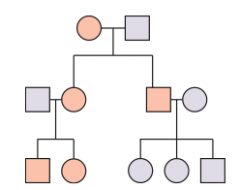
- Transmitted only through the mother
- All offspring of affected females may show signs of disease - Often due to failures in oxidative phosphorylation - May have variable expression in population due to heteroplasmy (presence of both normal and mutated mtDNA) |
|
|
What is an example of a mitochondrial disease? Implications?
|
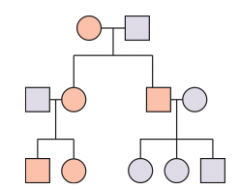
Mitochondrial Myopathies
- Groups of rare disorders resulting from mutations affecting mitochondrial function - Often present with myopathy and CNS disease - Muscle biopsy often shows "ragged red fibers" |
|
|
What is the cause of Achondroplasia? Inheritance pattern? Symptoms?
|
- Cause: Cell-signaling defect of Fibroblast Growth Factor (FGF) receptor 3
- Inheritance: Autosomal dominant (associated with advanced paternal age) - Symptoms: dwarfism, short limbs, larger head, trunk size is normal |
|
|
What is the cause of ADPKD? Inheritance pattern? Symptoms?
|
Autosomal-Dominant Polycystic Kidney Disease (ADPKD)
- Cause: 85% of cases d/t mutation in PKD1 gene on chromosome 16 (polycystic kidney has 16 letters) - Inheritance: adult form is autosomal dominant and infantile form is recessive - Symptoms: bilateral, massive enlargement of kidneys d/t multiple large cysts; flank pain, hematuria, HTN, progressive renal failure - Associated with: polycystic liver disease, berry aneurysms, mitral valve prolapse |
|
|
What is the cause of Familial Adenomatous Polyposis? Inheritance pattern? Symptoms?
|
- Cause: mutations on APC gene on chromosome 5 (polyp has 5 letters)
- Inheritance: autosomal dominant - Symptoms: colon is covered with adenomatous polyps after puberty, progresses to colon cancer unless colon is resected |
|
|
What is the cause of Familial Hypercholesterolemia (Hyperlipidemia type IIA)? Inheritance pattern? Symptoms?
|
- Cause: defective or absent LDL receptor
- Inheritance: autosomal dominant (heterozygous or homozygous) - Symptoms: elevated LDL (heterozygotes have cholesterol ~300 mg/dL, homozygotes are ~700m mg/dL); severe atherosclerotic disease early in life; tendon xanthomas (Achilles); MI possible before 20 |
|
|
What is the cause of Hereditary Hemorrhagic Telangiectasia (Osler-Weber-Rendu syndrome)? Inheritance pattern? Symptoms?
|
- Cause: disorder of blood vessels
- Inheritance: autosomal dominant - Symptoms: telangiectasia, recurrent epistaxis, skin discolorations, arteriovenous malformations (AVM) |
|
|
What is the cause of Hereditary Spherocytosis? Inheritance pattern? Symptoms?
|
- Cause: spectrin or ankyrin defect
- Inheritance: autosomal dominant - Symptoms: spheroid erythrocytes, hemolytic anemia, ↑ MCHC; splenectomy is curative |
|
|
What is the cause of Huntington's Disease? Inheritance pattern? Symptoms?
|
- Cause: chromosome 4 trinucleotide repeat disorder (CAG), leads to caudate atrophy ("Hunting 4 food")
- Inheritance: autosomal dominant - Symptoms: depression, progressive dementia, choreiform movements, ↓ levels of GABA and ACh in brain (onset between 20-50) |
|
|
What is the cause of Marfan's Syndrome? Inheritance pattern? Symptoms?
|
- Cause: Fibrillin-1 gene mutation
- Inheritance: autosomal dominant Symptoms: - CT disorder affecting skeleton, heart, and eyes - Tall with long extremities - Pectus excavatum - Hypermobile joints - Long, tapering fingers and toes (arachnodactyly) - Cystic medial necrosis of aorta → aortic incompetence and dissecting aortic aneurysm - Floppy mitral valve - Subluxation of lenses |
|
|
What is the cause of Multiple Endocrine Neoplasia (MEN)? Inheritance pattern? Symptoms?
|
- Cause: several distinct symptoms (1, 2A, 2B), MEN2A and 2B associated with "ret" gene
- Inheritance: autosomal dominant - Symptoms: Familial tumors of endocrine glands, including pancreas, parathyroid, pituitary, thyroid, and adrenal medulla |
|
|
What is the cause of Neurofibromatosis type 1 (von Recklinghausen's disease)? Inheritance pattern? Symptoms?
|
- Cause: on long arm of chromosome 17 (17 letters in "von Recklinghausen")
- Inheritance: autosomal dominant - Symptoms: café-au-lait spots, neural tumors, Lisch nodules (pigmented iris hamartomas); also skeletal disorders (scoliosis) and optic pathway gliomas |
|
|
What is the cause of Neurofibromatosis type 2? Inheritance pattern? Symptoms?
|
- Cause: NF2 gene on chromosome 22 (type 2 = 22)
- Inheritance: autosomal dominant - Symptoms: bilateral acoustic schwannomas |
|
|
What is the cause of Tuberous Sclerosis? Inheritance pattern? Symptoms?
|
- Cause: incomplete penetrance, variable presentation
- Inheritance: autosomal dominant - Symptoms: facial lesions (adenoma sebaceium), hypopigmented "ash leaf spots" on skin, cortical and retinal hamartomas, seizures, mental retardation, renal cysts, and renal angiomyolipomas, cardiac rhabdomyomas, ↑ incidence of astrocytomas |
|
|
What is the cause of von Hippel-Lindau disease? Inheritance pattern? Symptoms?
|
- Cause: deletion of VHL gene (tumor suppressor) on chromosome 3 (3 words for von Hippel-Lindau); leads to constitutive expression of HIF (transcription factor) and activation of angiogenic growth factors
- Inheritance: autosomal dominant - Symptoms: hemangioblastomas of retina / cerebellum / medulla; majority develop multiple bilateral renal cell carcinomas and other tumors |
|
|
What are some autosomal recessive diseases?
|
- Albinism
- ARPKD (aka infantile polycystic kidney disease) - Cystic Fibrosis - Glycogen Storage Diseases - Hemochromatosis - Mucopolysaccharidoses (except Hunter's) - Phenylketonuria - Sickle Cell Anemias - Sphingolipidoses (except Fabry's) - Thalassemias |
|
|
What is the cause of Cystic Fibrosis?
|
- Autosomal recessive defect in CFTR gene on chromosome 7
- Commonly deletion of Phe 508 |
|
|
What is the function of the CFTR gene?
|
Forms a channel:
- Actively secretes Cl- in lungs and GI tract - Actively reabsorbs Cl- from sweat |
|
|
What happens if there is a defect in CFTR gene?
|
Cystic Fibrosis
Defective Cl- channel: - Abnormal protein folding results in degradation of channel before reaching cell surface |
|
|
What are the symptoms of Cystic Fibrosis?
|
- Secretion of abnormally thick mucus that plugs lungs, pancreas, and liver
- Leads to recurrent pulmonary infections (Pseudomonas species and S. aureus), chronic bronchitis, and bronchiectasis - Pancreatic insufficiency (malabsorption and steatorrhea) - Nasal polyps - Meconium ileus in newborns - Infertility in males d/t bilateral absence of vas deferens - Fat soluble vitamin deficiencies (A, D, E, K) - Can present as failure to thrive in infancy |
|
|
What is the most common lethal genetic disease of white population?
|
Cystic Fibrosis
|
|
|
How do you diagnose and treat Cystic Fibrosis?
|
- Diagnose: ↑ concentration of Cl- ions in sweat test
- Treatment: N-acetylcysteine to loosen mucus plugs (cleaves disulfide bonds within mucus glycoproteins) |
|
|
What are the X-linked recessive disorders?
|
Be Wise, Fool's GOLD Heeds Silly HOpe
- Bruton's agammaglobulinemia - Wiskott-Aldrich syndrome - Fabry's Disease - G6PD deficiency - Ocular albinism - Lesch-Nyhan syndrome - Duchenne's (and Becker's) muscular dystrophy - Hunter's syndrome - Hemophilia A and B - Ornithine transcarbamoylase deficiency |
|
|
Who is affected by X-linked recessive disorders?
|
- Males more commonly affected
- Female carriers may be affected - May have less severe symptoms d/t random X chromosome inactivation in each cell |
|
|
What causes Duchenne's Muscular Dystrophy?
|
- X-linked frameshift mutation
- Deletion of dystrophin gene - Accelerated muscle breakdown |
|
|
What are the symptoms of Duchenne's Muscular Dystrophy?
|
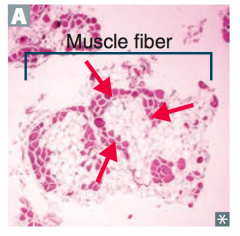
- Weakness begins in pelvic girdle muscles and progresses superiorly
- Pseudohypertrophy of calf muscles d/t fibrofatty replacement of muscle - Cardiac myopathy - Use of Gower's maneuver (requiring assistance of UEs to stand up) - Onset before 5 years |
|
|
What is the longest known human gene? Implications? Function?
|
Dystrophin gene → ↑ rate of spontaneous mutation
- Helps anchor muscle fibers, primarily in skeletal and cardiac muscle |
|
|
What causes Becker's Muscular Dystrophy?
|
X-linked mutated dystrophin gene
|
|
|
How do Duchenne's and Becker's Muscular Dystrophy compare in severity and onset?
|
- Duchenne's is more severe
- Duchenne's onset: <5 years of age - Becker's onset: adolescence or early adulthood |
|
|
How do you diagnose muscular dystrophies?
|
↑ CPK and muscle biopsy
|
|
|
What causes Fragile X Syndrome?
|
- X-linked defect affecting the methylation and expression of the FMR1 gene
- Trinucleotide repeat disorder (CGC) |
|
|
What are the top two causes of genetic mental retardation?
|
1. Down Syndrome
2. Fragile X Syndrome |
|
|
What are the symptoms / findings of Fragile X Syndrome?
|
Fragile X = eXtra large testes, jaw, ears
- Macroorchidism (enlarged testes) - Long face with a large jaw - Large everted ears - Autism - Mitral valve prolapse |
|
|
What are the trinucleotide repeat expansion disorders?
|
TRY (trinucleotide) HUNTING for MY FRIED EGGS (X)
- HUNTINGton's Disease = CAG - MYOtonic dystrophy = CTG - FRIEDreich's ataxia = GAA - Fragile X Syndrome = CGG |
|
|
What is the characteristic of all trinucleotide repeat expansion diseases?
|
May show genetic anticipation (↑ disease severity and ↓ age of onset in successive generations)
|
|
|
What are the autosomal trisomies? What chromosome is tripled?
|
- Down Syndrome (21) - Drinking age
- Edward's Syndrome (18) - Election age - Patau's Syndrome (13) - Puberty age |
|
|
What are the symptoms / findings of Down Syndrome?
|
- Mental retardation
- Flat facies - Prominent epicanthal folds - Simian crease - Gap between 1st 2 toes - Duodenal atresia - Congenital heart disease (most commonly ostium primum - type ASD) |
|
|
What does Down Syndrome increase your risk of?
|
- ALL
- Alzheimer's Disease (>35 years of age) |
|
|
What causes Down Syndrome?
|
- 95% d/t meiotic nondisjunction of homologous chromosomes (associated w/ advanced maternal age, from 1:1500 in women <20 to 1:25 in women >45)
- 4% of cases d/t Robertsonian translocation - 1% of cases d/t Down mosaicism (no maternal association) |
|
|
What is the most common viable chromosomal disorder? Second most common?
|
- Most common: Down Syndrome - trisomy 21
- Second: Edwards' Syndrome - trisomy 18 |
|
|
What are the results of the pregnancy quad screen if the fetus has Down Syndrome?
|
- ↓ α-Fetoprotein
- ↑ β-hCG - ↓ Estriol - ↑ Inhibin A |
|
|
What are the results of the ultrasound if the fetus has Down Syndrome?
|
↑ Nuchal translucency in first trimester
|
|
|
What are the symptoms / findings of Edwards' Syndrome?
|
- Severe mental retardation
- Rocker-bottom feet - Micrognathia (small jaw) - Low-set Ears - Clenched hands - Prominent occiput - Congenital heart disease - Death usually occurs within 1 year of birth |
|
|
What are the results of the pregnancy quad screen if the fetus has Edwards' Syndrome?
|
- ↓ α-Fetoprotein
- ↓ β-hCG - ↓ Estriol - Normal Inhibin A |
|
|
What are the symptoms / findings of Patau's Syndrome?
|
- Severe mental retardation
- Rocker-bottom feet - Microphthalmia (small eyes) - Microcephaly - Cleft liP/Palate - HoloProsencephaly (forebrain does not split in 2) - Polydactyly - Congenital heart disease - Death usually occurs within 1 year of birth |
|
|
What are the results of the first-trimester pregnancy screen if the fetus has Patau's Syndrome?
|
- ↓ free β-hCG
- ↓ PAPP-A - ↑ Nuchal translucency |
|
|
What happens in a Robertsonian Translocation?
|
- Non-reciprocal chromosomal translocation that commonly involves chromosomes 13, 14, 15, 21, and 22
- One of the most common types of translocation - Occurs when long arms of 2 acrocentric chromosomes (chromosomes with centromeres near their ends) fuse at the centromere and the 2 short arms are lost |
|
|
What are the possible implications of a Robertsonian Translocation?
|
- Balanced: normally do not cause any abnormal phenotype
- Unbalanced: can result in miscarriage, stillbirth, and chromosomal imbalance (eg, Down Syndrome, Patau's Syndrome) |
|
|
What causes Cri-du-Chat Syndrome?
|
Congenital microdeletion of short arm of chromosome 5 (46,XX or XY 5p-)
|
|
|
What are the symptoms of Cri-du-Chat Syndrome?
|
- High-pitched crying / mewing (Cri-du-Chat = Cry of the Cat)
- Microcephaly - Moderate to severe mental retardation - Epicanthal folds - Cardiac abnormalities (VSD) |
|
|
What causes Williams Syndrome?
|
Congenital microdeletion of long arm of chromosome 7 (deleted region includes elastin gene)
|
|
|
What are the symptoms of Williams Syndrome?
|
- Distinctive "elfin" facies
- Intellectual disability - Hypercalcemia (↑ sensitivity to vitamin D) - Well-developed verbal skills - Extreme friendliness with strangers - Cardiovascular problems |
|
|
What is caused by 22q11 deletion syndromes?
|
- DiGeorge Syndrome
- Velocardiofacial Syndrome |
|
|
How do patients with 22q11 deletion present?
|
CATCH-22 (d/t aberrant development of 3rd and 4th branchial POUCHES)
- Cleft palate - Abnormal facies - Thymic aplasia → T-cell deficiency - Cardiac defects - Hypocalcemia 2° to parathyroid aplasia - 22: microdeletion at chromosome 22q11 |
|
|
What are the specific findings of DiGeorge Syndrome?
|
- Thymic, parathyroid, and cardiac defects
- Microdeletion at chromosome 22q11 |
|
|
What are the specific findings of Velocardiofacial Syndrome?
|
- Palate, facial, and cardiac defects
- Microdeletion at chromosome 22q11 |

